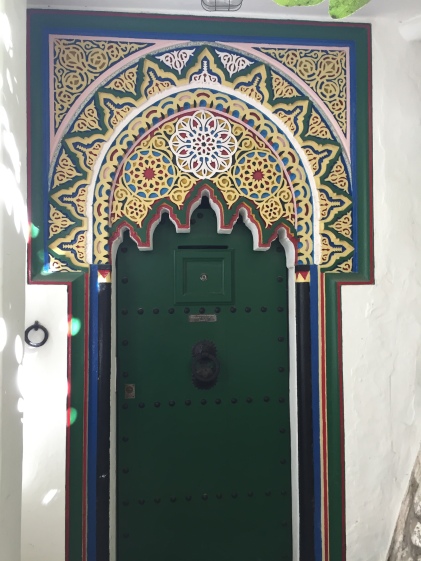I began our morning in Ouarzazate with a run through the neighborhood. About a mile from the hotel noticed three dogs across the street. This is very rare in the Arab world; cats can be seen on practically every street but seeing dogs seemed foreign even to me after all these weeks. See Alan’s article for more on that disparity (some believe dogs entering the house can cause angels to leave). Anyway, the sizable dogs, upon seeing me run past their domain, began barking and chasing me. I quadrupled my speed, booking it for my dear life. Fortunately for me, their owner called them off almost immediately, and I continued my run with a significant boost in calorie burning.
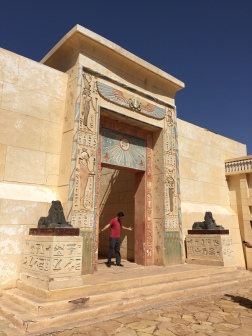
After departing the hotel our first stop was the Atlas Film Studios. Films such as Lawrence of Arabia, Patton, The Mummy, Gladiator, and Kingdom of Heaven were shot here. We walked through the highly realistic movie sets, including Ancient Egyptian tombs, old city alleys, Asian statues, a chariot, and an airplane. Farther in we witnessed even larger models of Egyptian architecture. As a child, I had been obsessed with Ancient Egypt. I went as far as memorizing the sounds made by each hieroglyph. I appreciated the massive walls of ancient artwork with awe, knowing it was fabricated but still admiring its realistic appearance.
Our next stop was Aït Ben Haddou, a nearby ancient fortified city. There are 4 families still 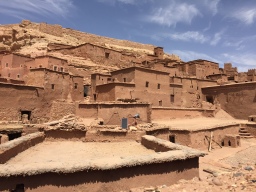 living in the ancient city–one of which had a problem with us being there, it seemed. Our mentor Youness later explained to me that his heated argument with the old man there was regarding a misunderstanding on who had to pay what to enter. Regardless, we got to walk among the maze of forts (Kasbahs) and palaces, all built of earthen clay architecture–I marveled at how they managed to build a sturdy building out of what seemed like mud, rocks, and wooden beams. At the very top of the hill we beheld an incredible sight in all directions: the brown city, the dried-up river, the newer city beyond it, the mountains in the distance, the desert on the other side, and the maroon mountain ranges deep in the horizon. I don’t know if I’ve ever seen such a vast expanse of sparsely filled space.
living in the ancient city–one of which had a problem with us being there, it seemed. Our mentor Youness later explained to me that his heated argument with the old man there was regarding a misunderstanding on who had to pay what to enter. Regardless, we got to walk among the maze of forts (Kasbahs) and palaces, all built of earthen clay architecture–I marveled at how they managed to build a sturdy building out of what seemed like mud, rocks, and wooden beams. At the very top of the hill we beheld an incredible sight in all directions: the brown city, the dried-up river, the newer city beyond it, the mountains in the distance, the desert on the other side, and the maroon mountain ranges deep in the horizon. I don’t know if I’ve ever seen such a vast expanse of sparsely filled space.
On a break on our way to Marrakesh we spotted several live lambs in the trunk of someone’s car. We understood they were the essential part of preparation for Eid al-Adha, the Muslims’ holiest celebrated holiday. It honors the willingness of Ibrahim (Abraham) to sacrifice his son, as an act of submission to God’s command, before God then intervened with his angel Jibra’il (Gabriel). This signifies that one should never sacrifice a human life, especially not in the name of God, and the spot where the well spared the child’s life later became the site where the Meccan Kaaba was built by Abraham and Ishmael himself.
After settling into our hotel in Marrakesh we went to Jemaa el-Fnaa, the massive, main square of the old medina. As we walked through I looked around the huge cobblestone area, appreciating how much space there was for congregation and meandering. We headed to the marketplace area for dinner: lamb with pieces of bread dipped in the lamb juice. I don’t think I’ve ever tasted this meat but it was tasty and satisfying. At the food stands we witnessed a crazy old man shouting at one of the vendors; he promptly threw a fruit at the guy, furiously spat at him, and stormed away, cursing him. It was comical. After ambling through the street markets to see the endless products, trinkets, and clothing, we headed back to the hotel to a bar with live music (all in English, unfortunately) to celebrate Nick’s 21st birthday.
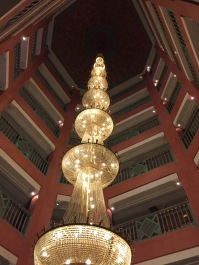 Sunday morning I managed to flood our hotel room. Okay, perhaps not “flood,” but I managed to get the bathroom floor and half of the bedroom covered in water. The pressure behind the showerhead was more powerful and the shower curtain less effective than I originally thought. But fear not, for with every towel and blanket in the room I could find I managed to soak up pretty much all of the immense quantity of water. In fact, I did so well that Glenn didn’t notice anything off about the room when he woke up. At breakfast I photographed all the spectacular artwork on the walls of the cafeteria.
Sunday morning I managed to flood our hotel room. Okay, perhaps not “flood,” but I managed to get the bathroom floor and half of the bedroom covered in water. The pressure behind the showerhead was more powerful and the shower curtain less effective than I originally thought. But fear not, for with every towel and blanket in the room I could find I managed to soak up pretty much all of the immense quantity of water. In fact, I did so well that Glenn didn’t notice anything off about the room when he woke up. At breakfast I photographed all the spectacular artwork on the walls of the cafeteria.
Next we revisited Jemaa el-Fnaa, where a lot of us got ripped off by the snake charmers, who all demanded as much as 400 dirhams ($40) for the photos they encouraged us to  take with them. Afterwards we headed to the Koutoubia mosque, walked around it, and then headed to a old Arabic mansion–spread out over a large area but never taller than a story. Glenn and I briefly got lost among its maze of patterned walls, tiled floors, intricately-decorated ceilings, and beautiful gardens. I wondered if I would be able to even make use of the whole place if I lived there. Outside we were all captivated by a feather floating to the ground at a super fast rotational speed but low linear one (so engineering). Once back in Rabat we had a cheery dinner at our favorite American establishment: McDonalds.
take with them. Afterwards we headed to the Koutoubia mosque, walked around it, and then headed to a old Arabic mansion–spread out over a large area but never taller than a story. Glenn and I briefly got lost among its maze of patterned walls, tiled floors, intricately-decorated ceilings, and beautiful gardens. I wondered if I would be able to even make use of the whole place if I lived there. Outside we were all captivated by a feather floating to the ground at a super fast rotational speed but low linear one (so engineering). Once back in Rabat we had a cheery dinner at our favorite American establishment: McDonalds.
Our weekdays were challenged by the fact that every store was closed. Especially in the beginning of the week–Eid was in full swing and no businesses were open. At night we heard the bleating of the lambs on death row. Our 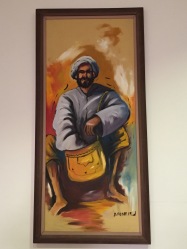 professors had warned us of this, so we’d gone grocery shopping in preparation; we had to resort to cooking for ourselves more often. We did manage a meal at Café Malak, at which a random old Moroccan man wearing a fez hat came around the table and laid a single warm almond in front of each of us. He heard us speaking Spanish and began telling us a number of jokes in Spanish. Alan requested an interview with the man to try and learn about European neo-colonialism (for his research project); after the interview Alan professed that the man is missing a screw or two because he was unable to speak in anything but jokes.
professors had warned us of this, so we’d gone grocery shopping in preparation; we had to resort to cooking for ourselves more often. We did manage a meal at Café Malak, at which a random old Moroccan man wearing a fez hat came around the table and laid a single warm almond in front of each of us. He heard us speaking Spanish and began telling us a number of jokes in Spanish. Alan requested an interview with the man to try and learn about European neo-colonialism (for his research project); after the interview Alan professed that the man is missing a screw or two because he was unable to speak in anything but jokes.
This week I came to notice daily things that I’ve only ever seen in Morocco.
I found out that the curious, strange fruits I’d seen piled up on carts in the medina were grown on cacti (I would never have guessed cacti could grow fruit).
I noticed that throughout Morocco, most young men have the same unique haircut–short, wavy hair overall but a buzz on half the head that reaches to the middle of the forehead.
Ants and mosquitoes seem more prevalent here; the latter vexing me greatly.
As I’d said several times before, there are cats everywhere. I even saw a bunch of kittens chilling among the rocks at the pier on the Salé side of the Bou Regreg when I went jogging down there.
In most cafés where I order hot chocolate, the glass comes with thick chocolate syrup at the bottom and warm milk on top. On the side comes a packet of sugar. The mixing is left to me. A bottle of water is often served along with it too.
Nutella is served everywhere. Even Spanish churros are served with Nutella instead of hot chocolate. It is always an available condiment.
Some doors, especially in the medina, are surprisingly small. You’d have to be a midget to pass through with ease. Shady informed me that historically they were built that way to prevent colonialists or authorities from entering into a citizen’s house on their horse; much less intimidating to face them eye-to-eye.
On Wednesday we met with a law student who introduced himself with the traditional handshake immediately followed by a hand over his heart; we see this every time we meet someone.
Thursday was our last Darija class. For the first hour we had our final quiz, in which we had several Arabic letters to put together into words (the letters change according to their location in the word) and a mini-essay that had to describe our past weekly activities in 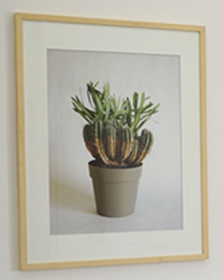 Morocco. I threw every Darijan word I could remember into it. We thanked Karima greatly after our class ended for her phenomenal teaching. She really knows how to effectively explain the fundamental points and vocabulary of a completely foreign language to us in a short period of time. After class I headed to LeCube, an independent art studio with a Moroccan’s artwork on display. He had a cactus that he was trying to biologically alter to grow leaves instead of thorns, as they used to have before evolving. He’s from the Western Sahara disputed territory (originally occupied by Spain until it was claimed by Morocco in the Green March) and photographs the sparsely populated, borderline-ghost towns that he grew up in. A woman that works there explained this to me in French as she showed me all of the photographs on the walls and the ceramic works in the back room.
Morocco. I threw every Darijan word I could remember into it. We thanked Karima greatly after our class ended for her phenomenal teaching. She really knows how to effectively explain the fundamental points and vocabulary of a completely foreign language to us in a short period of time. After class I headed to LeCube, an independent art studio with a Moroccan’s artwork on display. He had a cactus that he was trying to biologically alter to grow leaves instead of thorns, as they used to have before evolving. He’s from the Western Sahara disputed territory (originally occupied by Spain until it was claimed by Morocco in the Green March) and photographs the sparsely populated, borderline-ghost towns that he grew up in. A woman that works there explained this to me in French as she showed me all of the photographs on the walls and the ceramic works in the back room.
At 5:00 the next morning we got up to pack for our trip to Tangier. We got to the station 20 minutes early, as we’d seen firsthand how prompt the trains are here. It departed at 6:37 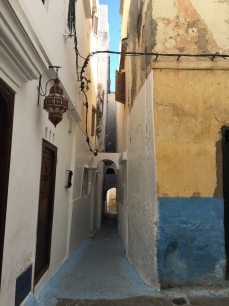 EXACTLY. No mercy for anyone that is running remotely late. They say that the train and the addan (Call to Prayer) are the two things that are always right on time in Morocco. I slept so well on the train (as I always do) that it felt like we got to the northern coast in no time at all. Saad Lamjarred welcomed us to the city. Well, not personally, but his wide grin on a massive billboard seemed inviting enough. We had trouble getting into our apartment, little luck in finding an open restaurant, and were pestered by a particularly persistent young boy begging for cash. After more than 10 minutes we gave him a coin and told him not to spend it on hashish. The city looked far more European than Moroccan, especially in the way cars actually stopped for us as we crossed the street (woah!).
EXACTLY. No mercy for anyone that is running remotely late. They say that the train and the addan (Call to Prayer) are the two things that are always right on time in Morocco. I slept so well on the train (as I always do) that it felt like we got to the northern coast in no time at all. Saad Lamjarred welcomed us to the city. Well, not personally, but his wide grin on a massive billboard seemed inviting enough. We had trouble getting into our apartment, little luck in finding an open restaurant, and were pestered by a particularly persistent young boy begging for cash. After more than 10 minutes we gave him a coin and told him not to spend it on hashish. The city looked far more European than Moroccan, especially in the way cars actually stopped for us as we crossed the street (woah!).
After finding food at a restaurant freshly opened from Eid (so early that they didn’t have water to serve yet) we headed up a massive rocky hill to the medina, and within it, the kasbah. At its entrance a skinny, short, wise old Moroccan spontaneously became our tour guide and showed us the former residencies of several world-famous artists, writers, and musicians. He even explained the history and significance of the colors the walls were painted in, and the symbols on the doorknockers. He told me the Hand of Fatima I wore as a necklace was to bring me good luck. I learned he spoke more than 5 languages, much like the old Berber man in Chefchaouen. At one point we got a view of the immense Atlantic Ocean, the Mediterranean Sea, and the distant landmass known as Spain in between them. To me it looked surprisingly closer than 14 kilometers. After paying and thanking our old friend Abdullah we walked along the beach and later ate a large and satisfying feast to end the week. It was satisfying to have made it to yet another unique city in Morocco.